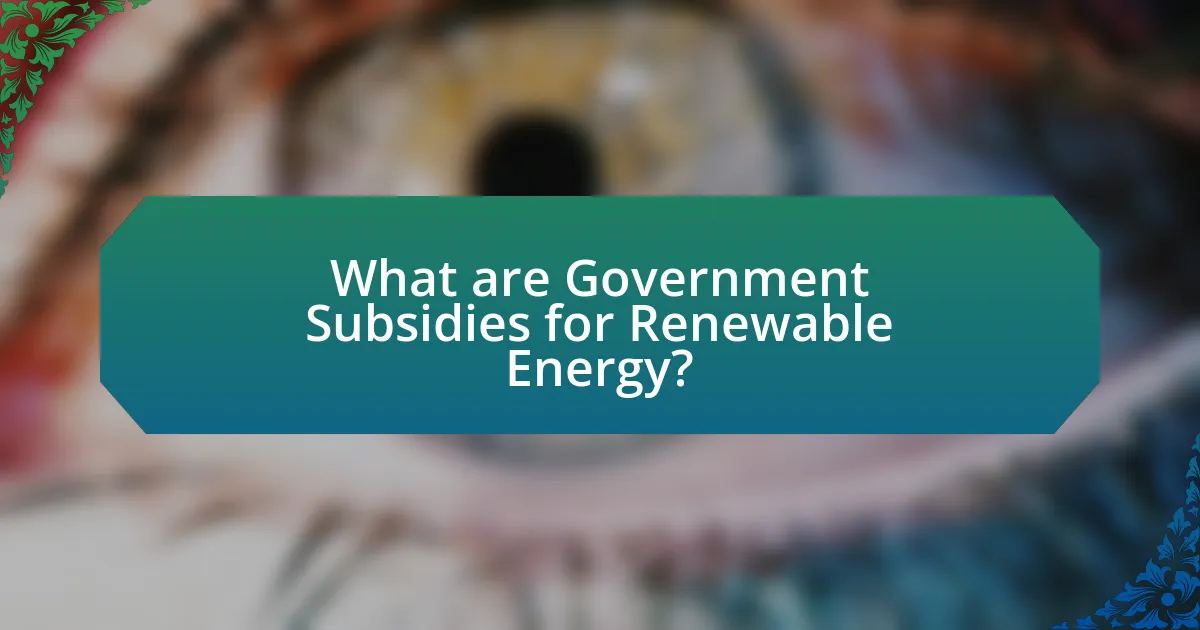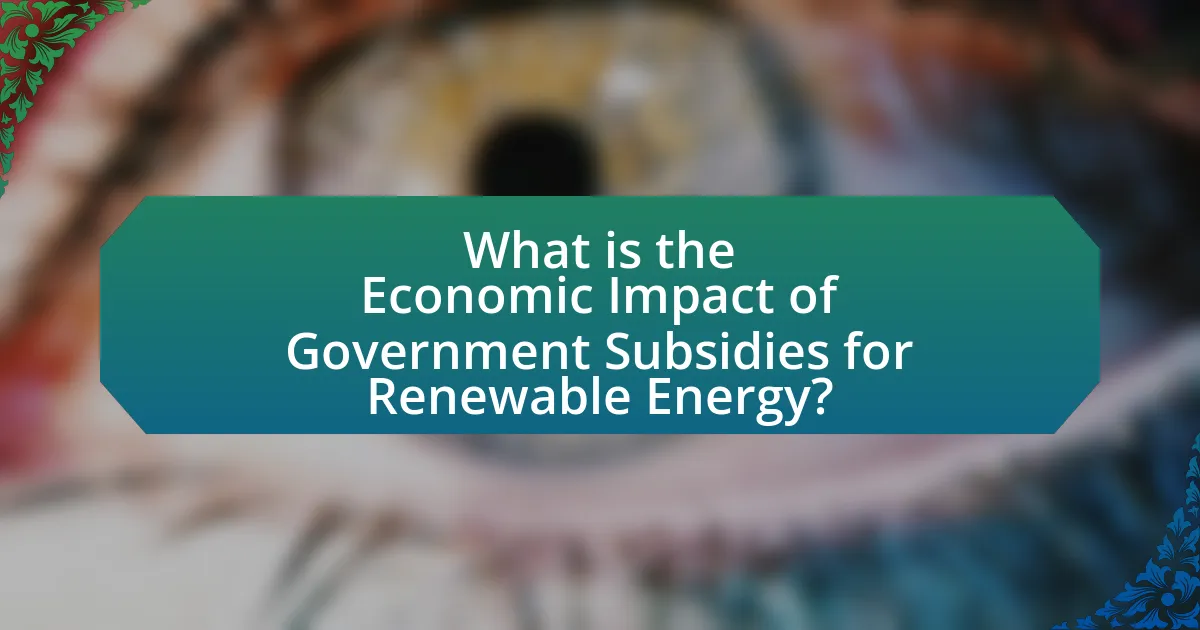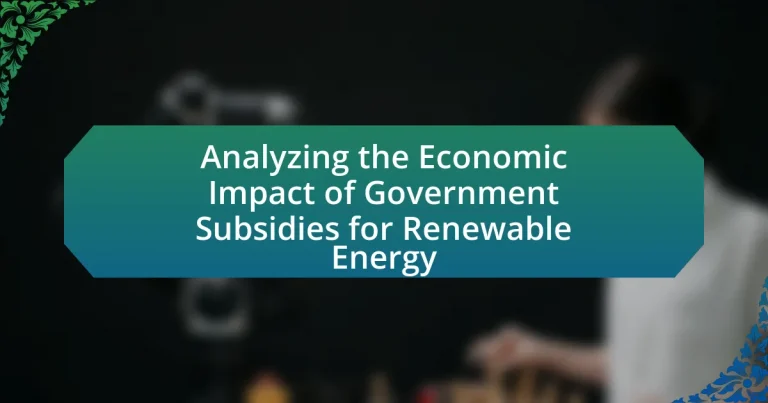Government subsidies for renewable energy are financial incentives provided by governments to encourage the development and adoption of clean energy sources such as solar, wind, and biomass. This article analyzes the economic impact of these subsidies, detailing their various forms, including tax credits, grants, and low-interest loans, and their role in reducing costs and promoting investment in renewable technologies. It explores how subsidies influence market dynamics, job creation, and overall economic growth, while also addressing potential drawbacks such as market distortions and dependency on government funding. Additionally, the article evaluates the effectiveness of subsidy programs and highlights best practices for enhancing their impact on renewable energy adoption.

What are Government Subsidies for Renewable Energy?
Government subsidies for renewable energy are financial incentives provided by governments to promote the development and adoption of renewable energy sources such as solar, wind, and biomass. These subsidies can take various forms, including tax credits, grants, and low-interest loans, aimed at reducing the cost of renewable energy projects and encouraging investment in clean energy technologies. For instance, in the United States, the Investment Tax Credit (ITC) allows for a significant percentage of the investment in solar energy systems to be deducted from federal taxes, which has contributed to a substantial increase in solar installations. According to the U.S. Department of Energy, these subsidies have played a crucial role in driving down the costs of renewable energy, making it more competitive with fossil fuels and facilitating a transition towards a more sustainable energy future.
How do government subsidies function in the renewable energy sector?
Government subsidies in the renewable energy sector function by providing financial support to reduce the cost of developing and deploying renewable energy technologies. These subsidies can take various forms, including tax credits, grants, and low-interest loans, which incentivize investment in renewable energy projects such as solar, wind, and bioenergy. For instance, the Investment Tax Credit (ITC) in the United States allows investors to deduct a significant percentage of the cost of solar energy systems from their federal taxes, thereby lowering the overall financial burden and encouraging more installations. According to the International Renewable Energy Agency (IRENA), government subsidies have been instrumental in driving down the costs of renewable technologies, contributing to a 90% reduction in the cost of solar photovoltaic systems since 2010.
What types of subsidies are available for renewable energy projects?
Various types of subsidies are available for renewable energy projects, including direct financial grants, tax credits, and feed-in tariffs. Direct financial grants provide upfront funding to support project development, while tax credits, such as the Investment Tax Credit (ITC) and Production Tax Credit (PTC) in the United States, incentivize investment by reducing tax liabilities. Feed-in tariffs guarantee fixed payments for energy produced from renewable sources, ensuring stable revenue for project developers. These subsidies are designed to lower the cost of renewable energy projects, promote investment, and accelerate the transition to sustainable energy sources.
How do subsidies influence the market dynamics of renewable energy?
Subsidies significantly influence the market dynamics of renewable energy by lowering production costs and encouraging investment. When governments provide financial support, such as tax credits or direct payments, they make renewable energy projects more economically viable, which can lead to increased supply and competition in the market. For instance, the U.S. solar industry has grown substantially due to the Investment Tax Credit, which has incentivized over $140 billion in solar investments from 2010 to 2020. This influx of capital not only accelerates technological advancements but also drives down prices for consumers, making renewable energy sources more accessible.
Why are government subsidies important for renewable energy development?
Government subsidies are crucial for renewable energy development because they lower the financial barriers for investment in clean technologies. By providing financial support, governments can stimulate innovation, reduce the cost of renewable energy projects, and encourage private sector participation. For instance, the International Renewable Energy Agency reported that subsidies have led to a significant decrease in the cost of solar and wind energy, making them more competitive with fossil fuels. In 2020, global investment in renewable energy reached $303.5 billion, largely driven by supportive policies and subsidies. This financial backing not only accelerates the transition to sustainable energy sources but also creates jobs and promotes economic growth in the renewable sector.
What role do subsidies play in reducing the cost of renewable energy technologies?
Subsidies significantly reduce the cost of renewable energy technologies by providing financial support that lowers the initial investment and operational expenses. This financial assistance encourages manufacturers to scale production, leading to economies of scale that further decrease costs. For instance, the International Renewable Energy Agency reported that global solar photovoltaic (PV) costs fell by 82% between 2010 and 2019, largely due to government subsidies and incentives that stimulated market growth and technological advancements. Thus, subsidies play a crucial role in making renewable energy more affordable and accessible.
How do subsidies contribute to achieving national energy goals?
Subsidies contribute to achieving national energy goals by providing financial support that incentivizes the development and adoption of renewable energy technologies. This financial assistance lowers the cost of production and installation for renewable energy sources, making them more competitive with fossil fuels. For instance, the International Renewable Energy Agency reported that global solar photovoltaic costs fell by 82% between 2010 and 2019, largely due to government subsidies and incentives. By reducing barriers to entry, subsidies facilitate increased investment in clean energy projects, leading to a more sustainable energy mix and reduced greenhouse gas emissions, which align with national energy objectives.

What is the Economic Impact of Government Subsidies for Renewable Energy?
Government subsidies for renewable energy significantly stimulate economic growth by promoting job creation, increasing investment in clean technologies, and reducing energy costs. For instance, a report by the International Renewable Energy Agency (IRENA) indicates that the renewable energy sector employed over 11 million people globally in 2018, a number that has continued to rise due to supportive policies. Additionally, subsidies lower the cost of renewable energy projects, making them more competitive with fossil fuels, which can lead to lower energy prices for consumers. According to the U.S. Energy Information Administration, the levelized cost of electricity from solar and wind has decreased by 88% and 69%, respectively, since 2009, largely due to government incentives. These economic impacts demonstrate that government subsidies are crucial for accelerating the transition to a sustainable energy future.
How do subsidies affect the overall economy?
Subsidies significantly influence the overall economy by altering market dynamics, encouraging investment, and promoting specific industries. For instance, government subsidies for renewable energy have led to increased production and consumption of clean energy, resulting in job creation and technological advancements. According to a report by the International Renewable Energy Agency, the renewable energy sector employed over 11 million people globally in 2018, demonstrating the positive economic impact of such subsidies. Additionally, subsidies can lower energy costs for consumers, stimulate economic growth, and reduce reliance on fossil fuels, contributing to a more sustainable economic framework.
What are the short-term economic benefits of renewable energy subsidies?
Renewable energy subsidies provide immediate economic benefits such as job creation, increased investment in clean technologies, and reduced energy costs for consumers. These subsidies stimulate the renewable energy sector, leading to the creation of approximately 3 million jobs in the U.S. alone as reported by the International Renewable Energy Agency in 2021. Additionally, subsidies attract private investment, with global investments in renewable energy reaching $303.5 billion in 2020, fostering innovation and technological advancements. Furthermore, by lowering the cost of renewable energy sources, subsidies can lead to decreased electricity prices for consumers, enhancing affordability and economic stability in the short term.
How do subsidies influence job creation in the renewable energy sector?
Subsidies significantly enhance job creation in the renewable energy sector by providing financial support that lowers operational costs and encourages investment. This financial backing enables companies to expand their workforce, as seen in the U.S. solar industry, which employed over 250,000 workers in 2019, largely due to federal and state subsidies. Additionally, a report from the International Renewable Energy Agency indicates that global renewable energy jobs reached 11.5 million in 2018, driven by supportive policies and subsidies. These subsidies not only stimulate direct employment in renewable energy projects but also create indirect jobs in related sectors, such as manufacturing and installation, thereby amplifying overall economic growth.
What are the potential drawbacks of government subsidies for renewable energy?
Government subsidies for renewable energy can lead to market distortions and inefficiencies. These subsidies may encourage over-reliance on government support, reducing the incentive for innovation and cost reduction among renewable energy producers. For instance, a study by the International Energy Agency found that subsidies can create a dependency that stifles competition, as established companies may dominate the market due to their ability to secure funding, while smaller firms struggle to compete without similar support. Additionally, subsidies can divert public funds from other critical areas, such as education or healthcare, leading to opportunity costs that may outweigh the benefits of renewable energy development.
How can subsidies lead to market distortions?
Subsidies can lead to market distortions by artificially lowering the prices of goods or services, which disrupts the natural supply and demand balance. When governments provide financial support to specific industries, such as renewable energy, it can encourage overproduction and misallocation of resources. For instance, the International Energy Agency reported that global fossil fuel subsidies reached $400 billion in 2020, which can divert investment away from more efficient or sustainable energy sources. This results in an inefficient market where prices do not reflect true production costs, leading to potential long-term economic inefficiencies and hindering competition.
What are the risks of dependency on government funding in renewable energy?
Dependency on government funding in renewable energy poses several risks, including financial instability, market distortion, and reduced innovation. Financial instability arises when projects rely heavily on subsidies, making them vulnerable to budget cuts or policy changes, as seen in countries like Spain, where abrupt subsidy reductions led to project cancellations and investor losses. Market distortion occurs when government funding creates an uneven playing field, favoring certain technologies over others, which can stifle competition and lead to inefficiencies. Additionally, reliance on government support may reduce the incentive for companies to innovate, as they may prioritize securing funding over developing cost-effective solutions, evidenced by the stagnation in some sectors where subsidies are prevalent.

How can the effectiveness of government subsidies for renewable energy be measured?
The effectiveness of government subsidies for renewable energy can be measured through various quantitative metrics, including the increase in renewable energy capacity, reduction in greenhouse gas emissions, and economic indicators such as job creation in the renewable sector. For instance, a study by the International Renewable Energy Agency (IRENA) reported that global renewable energy jobs reached 11.5 million in 2018, partly due to supportive policies and subsidies. Additionally, the levelized cost of electricity (LCOE) for solar and wind energy has significantly decreased, with solar costs dropping by 89% since 2009, indicating the impact of subsidies on market competitiveness. These metrics provide concrete evidence of the effectiveness of subsidies in promoting renewable energy adoption and achieving environmental goals.
What metrics are used to evaluate the success of renewable energy subsidies?
Metrics used to evaluate the success of renewable energy subsidies include cost-effectiveness, job creation, greenhouse gas emissions reduction, and energy production levels. Cost-effectiveness measures the economic efficiency of subsidies by comparing the cost per unit of energy produced to traditional energy sources. Job creation metrics assess the number of jobs generated in the renewable energy sector as a direct result of subsidies, with studies indicating that investments in renewable energy create more jobs per dollar than fossil fuels. Greenhouse gas emissions reduction quantifies the decrease in emissions attributable to increased renewable energy use, supporting climate goals. Energy production levels track the amount of energy generated from renewable sources, demonstrating the impact of subsidies on energy supply. These metrics provide a comprehensive framework for assessing the effectiveness of government subsidies in promoting renewable energy.
How do we assess the return on investment for government subsidies?
To assess the return on investment for government subsidies, one must evaluate the economic benefits generated relative to the costs incurred. This assessment typically involves analyzing metrics such as job creation, increased tax revenues, and energy cost savings resulting from the subsidies. For instance, a study by the International Renewable Energy Agency found that every dollar invested in renewable energy subsidies can yield up to three dollars in economic returns through job creation and reduced energy costs. Thus, the effectiveness of government subsidies can be quantified by comparing these economic benefits against the initial financial outlay.
What are the long-term impacts of subsidies on renewable energy adoption rates?
Subsidies significantly enhance renewable energy adoption rates over the long term by reducing the financial barriers associated with initial investments. For instance, countries that implemented substantial subsidies, such as Germany with its Feed-in Tariff system, saw a dramatic increase in solar energy installations, growing from 0.1 gigawatts in 2000 to over 40 gigawatts by 2015. This financial support not only incentivizes the development of renewable technologies but also fosters market stability and encourages private investment. Additionally, studies indicate that sustained subsidies can lead to economies of scale, further decreasing costs and promoting wider adoption, as evidenced by the International Renewable Energy Agency’s report showing a 70% drop in solar photovoltaic costs from 2010 to 2020 due to increased production and technological advancements driven by initial subsidy frameworks.
What best practices can enhance the effectiveness of government subsidies for renewable energy?
To enhance the effectiveness of government subsidies for renewable energy, implementing targeted and transparent subsidy programs is essential. Targeted subsidies focus on specific technologies or sectors that demonstrate the highest potential for impact, such as solar or wind energy, which have shown significant cost reductions and scalability. Transparency in the allocation and use of subsidies fosters accountability and encourages private investment, as seen in countries like Germany, where clear guidelines have led to substantial growth in renewable energy capacity. Additionally, regular evaluation and adjustment of subsidy programs based on performance metrics ensure that funds are directed towards the most effective initiatives, as evidenced by the success of the U.S. Investment Tax Credit, which has driven substantial investment in solar energy.
How can policymakers design better subsidy programs?
Policymakers can design better subsidy programs by implementing targeted incentives that align with specific economic and environmental goals. For instance, utilizing data analytics to identify sectors that would benefit most from subsidies can enhance efficiency and effectiveness. Research indicates that targeted subsidies in renewable energy can lead to a 20% increase in adoption rates, as seen in countries like Germany, which successfully used feed-in tariffs to boost solar energy installations. Additionally, incorporating performance-based metrics ensures that subsidies are allocated based on measurable outcomes, thereby maximizing the impact of public funds.
What lessons can be learned from successful subsidy implementations in other countries?
Successful subsidy implementations in other countries demonstrate the importance of targeted financial support to stimulate renewable energy growth. For instance, Germany’s Feed-in Tariff system, established in 2000, effectively incentivized solar energy adoption, leading to a tenfold increase in solar capacity by 2015. This model illustrates that well-structured subsidies can drive investment, reduce costs, and enhance technology deployment. Additionally, Denmark’s wind energy subsidies have resulted in the country generating over 40% of its electricity from wind, showcasing how consistent policy support can create a robust renewable energy sector. These examples highlight that clear policy frameworks, long-term commitment, and adaptability to market conditions are crucial for successful subsidy programs.




